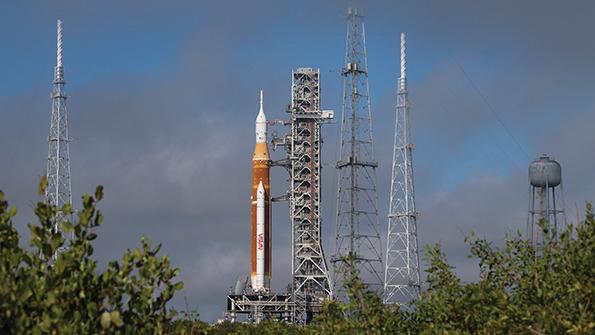
NASA’s decade-long, multibillion-dollar effort to restore crewed, deep-space transportation capabilities to the U.S. reached a final milestone ahead of launch: a two-day dress rehearsal that includes fueling the Space Launch System core and upper stages with 730,000 lb. of cryogenic propellants.
The Space Launch System (SLS) rocket, topped with an Orion capsule, rolled out from the Kennedy Space Center’s historic Vehicle Assembly Building (VAB) just before sunset on March 17, accompanied by a University of Central Florida marching band, 7,000 guests and a live NASA TV broadcast.
- Tanking test to complete design verification
- NASA targeting June for Artemis I launch
The vehicle’s arrival at Launch Complex 39B 10.5 hr. later set the stage for a wet dress rehearsal (WDR), which was scheduled for no earlier than April 1-3. The WDR is the last major test ahead of the SLS debut launch on the Artemis I mission, which will send the uncrewed Orion capsule on a flight test around the Moon. Liftoff is targeted for no earlier than June 6.
“This is our last design verification prior to our launch,” Tom Whitmeyer, associate administrator for common exploration systems development at NASA headquarters, told reporters on March 29. “We have done everything to get ready,” he added. “We will find out soon enough.”
The WDR primarily is intended to give the launch team practice fueling the vehicle and then draining it in the same environment as launch day. Ahead of the test, technicians checked interfaces between the mobile launcher and the pad and ran a series of tests that could not be accomplished in the VAB. Those included: communications tests, Orion radio frequency checks and guidance and navigation system checks on Orion and the SLS Interim Cryogenic Propulsion Stage (ICPS) upper stage. In addition, the hydraulic systems of the SLS’ solid rocket boosters were serviced.
The WDR was expected to get underway at 5 p.m. on April 1 with a “call to stations” for the test team. If all has gone well, on April 3 the SLS core and upper stages will be loaded with cryogenic liquid oxygen and hydrogen propellants, marking the first time the stages are fueled together.
The core stage tanks hold 537,000 gal. of liquid hydrogen and 196,000 gal. of liquid oxygen. The stage, built by Boeing, is designed to operate for about 480 sec. and then separate from the ICPS, the Orion stage adapter and the Orion capsule.
The core stage, which serves as the backbone of the SLS rocket, is powered by four RS-25 engines manufactured by Aerojet Rocketdyne. The engines, which will not be fired up during the WDR, were transferred from the space shuttle program, along with the shuttle solid rocket boosters, the mobile launcher platform and the launchpad.
NASA spent $20 billion on the SLS program in 2012-21, which covered development, testing and manufacturing of three core boosters and early work on an upgraded upper stage.
The ICPS, which will be used on the first three SLS flights, is a 45-ft.-tall, 16.7-ft.-dia. modified Delta Cryogenic Second Stage, which is used on United Launch Alliance’s (ULA) Delta IV launch vehicles. Manufactured by Boeing and ULA in Decatur, Alabama, the ICPS is designed to perform a translunar injection burn to send Orion toward the Moon. The stage, which is powered by a single Aerojet Rocketdyne RL10 engine, also contains the avionics to fly the mission from core stage separation to when Orion separates from the ICPS.
Modifications to the Delta stage for early SLS missions—a configuration referred to as Block 1—included lengthening the liquid hydrogen tank by 18.4 in. Other additions include: a second hydrazine bottle for attitude control, a new navigation system, Orion and launch vehicle stage adapter electrical and mechanical interfaces, a modified liquid-hydrogen vent and relief valve, and an RL10 inflight helium injector purge to support engine restart. The RL010 also had to be requalified to operate in SLS environments.
For the Artemis missions, the RL10 will conduct three burns. The first will circularize Orion’s orbit, the second will push the spacecraft out of Earth orbit toward the Moon and a final disposal burn after Orion separates will put the ICPS into a graveyard orbit around the Sun.
Joining the WDR team in Florida will be personnel at NASA’s Marshall Space Flight Center in Huntsville, Alabama, which oversees SLS development, and at NASA’s Johnson Space Center (JSC) in Houston, which is in charge of the Orion program. The capsule earmarked for the Artemis I flight test will be powered up and monitored throughout the WDR.
“This is a good practice run,” says Orion Program Manager Howard Hu. “We will have our engineering team from JSC and Mission Control do checkouts of the primary power, propulsion and communications systems. The flight software will be running, and the hatch closed.”
NASA has spent about $12 billion on the Orion program, including a 2014 flight test that launched aboard a ULA Delta IV Heavy booster.
Much of NASA’s confidence that the WDR will proceed smoothly is due to the amount of time and effort that has gone into preparations, says Charlie Blackwell-Thompson, the Artemis launch director at the Kennedy Space Center.
“We have tested all of the individual pieces. We have also run the software through a number of different simulations,” Blackwell-Thompson told reporters. “But it’s a test, so I’m certain as we go through things, we will learn.”
The WDR was expected to conclude by 5 p.m on April 3 after the launch team ran through countdown activities. The team planned to halt the rehearsal with 33 sec. left on the clock, cycle back to a 10-min. hold and then continue down to 10 sec. of what would be an actual liftoff. At that point, the team planned to proceed as if the launch had been scrubbed.
Ground teams expected then to drain the rocket and prepare to roll it back into the VAB for additional closeouts and tests while the outcome of the WDR was assessed. NASA leadership could be prepared to provide a time frame for launch the week of April 11.
The SLS and Orion will return to 39B about a week before the Artemis 1 is targeted to launch. If that occurs in the weeks following the WDR, a follow-on flight test, Artemis II, could send astronauts around the Moon and back to Earth in 2024. Artemis III, the first post-Apollo mission to land astronauts on the Moon, could follow in 2025.



Comments